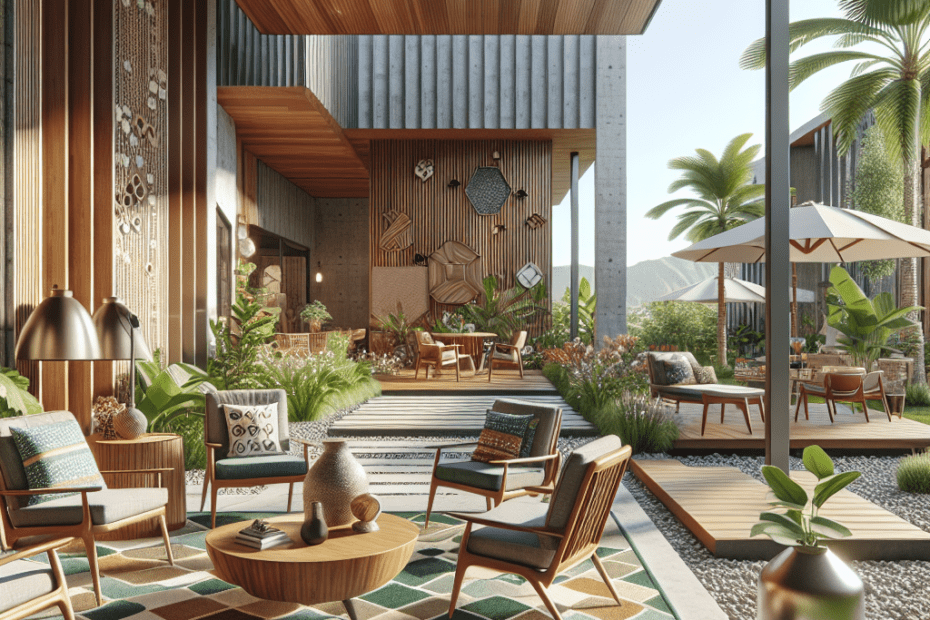“`html
When homeowners consider creating an outdoor oasis, many of them gravitate towards the elegant and
timeless design aesthetics of Mid-Century Modern Outdoor Design. Born in the mid-20th century, this
style, known for its clean lines, organic forms, and functional elegance, continues to charm outdoor
spaces today. They believe that blending nature with minimalist design can transform their gardens and
patios into serene retreats. With 59% of homeowners preferring a simple, elegant design for their
outdoor spaces (Houzz Landscaping Trends Study, 2020), the mid-century modern style is an ideal choice.
Elements of Mid-Century Modern Outdoor Design
For those seeking to revamp their outdoor areas, understanding key elements of the mid-century design can
help them achieve an authentic look. This style often incorporates a mix of natural materials and
modernist touches, creating a harmonious blend of tradition and innovation.
Furniture Selection
Furniture is the cornerstone of any outdoor space. They should aim to choose pieces with clean lines and
organic shapes. Materials like teak, metal, and rope are popular since they blend well with the
surroundings. Retro-inspired sun loungers, chic lounge chairs, and sleek tables often dominate such
spaces.
| Furniture Material | Characteristics |
|---|---|
| Teak | Durable, weather-resistant, and boasts a warm tone. |
| Metal | Lends a sleek, modern look. Choose rust-resistant metals like aluminum. |
| Rope | Offers texture and can soften the hard lines of furniture. |
Color Scheme
The mid-century palette is often earthy yet vibrant, with hues drawn from nature. Earth tones of brown,
green, and terracotta are complemented with bold splashes of mustard yellow, burnt orange, or turquoise.
For a cohesive look, they can match these colors with potted plants and colorful outdoor pillows.
Accessorizing
Incorporating playful and functional accessories brings life to the design. They should consider adding
geometric planters, retro-inspired lighting like string or globe lights, and functional yet stylish
items like colorful umbrellas or outdoor rugs. Accessories offer personality to the space without
overwhelming the design.
Landscaping
In terms of landscaping, they should aim to maintain a balance between structured and natural elements.
Mid-century modern gardens often have a mix of manicured lawns bordered by wild, native plants. They can
add striking planters at different heights to create depth and dimension. Paths with geometric paving
stones can guide them through the garden while maintaining the aesthetic appeal.
Sustainability in Mid-Century Modern Design
With growing concerns about sustainability, they may want to opt for eco-friendly materials. Many
homeowners now choose reclaimed wood and recycled metal for their outdoor furniture. Additionally,
incorporating local plant species can reduce water usage and maintenance.
Key Takeaways
- Mid-century modern design integrates natural materials with minimalist aesthetics.
- Focus on functional furniture with clean lines and organic shapes.
- Incorporate an earthy color palette with occasional vibrant accents.
- Choose thoughtful accessories to enhance the design.
- Explore sustainable options for a greener outdoor space.
FAQ
- Q: What is Mid-Century Modern Outdoor Design?
- A: This design style focuses on minimalism, functionality, and the integration of indoor and outdoor
spaces using natural and modern materials. - Q: What furniture materials are best for a mid-century modern outdoor space?
- A: Teak, metal, and rope are popular materials due to their durability and style.
- Q: How can they make their outdoor space sustainable?
- A: Use eco-friendly materials, recycle where possible, and choose native plants that require less
water. - Q: Which colors define the mid-century modern style?
- A: Earth tones, augmented with pops of bold hues like mustard yellow, burnt orange, or turquoise.
- Q: What are essential accessories for a mid-century modern look?
- A: Geometric planters, retro lighting fixtures, and colorful textiles.
“`
